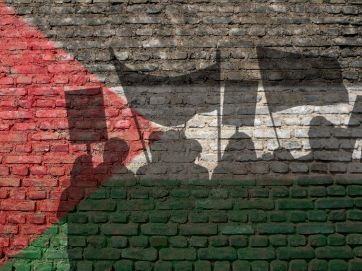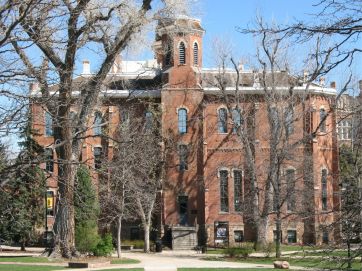I had worn green in hopes of camouflaging myself, lizard-like, among the others at the conference. But this lecture series featured “a different shade of green.” The Princeton Environmental Institute and the Center for African American Studies co-hosted “Race, Place, and Environmental Justice,” April 28 and 29. About 60 showed up Tuesday morning in an underground room in Princeton’s Frist Campus Center, including me, clutching a clear plastic-looking cup that proudly announced on its green strip, “MADE FROM CORN.” I also had my conference packet printed on “100% carbon neutral recycled paper,” and a pen on which was inscribed, “95% Recycled Barrel.” I made my way inside as the first speaker of the day, Beverly Wright, Director of the Deep South Center for Environmental Justice, was explaining that the Government’s solution for poverty is “moving poor people to another place.”
Dr. Wright, an emotionally engaged speaker, was principally concerned with New Orleans during and after Hurricane Katrina, which she used to exemplify the failures in the United States of “environmental justice” (which before long, everyone referred to in shorthand as E.J.). Wright told of the New Orleans higher-ups’ pervasive racism; of how a white “Officer Friendly is not all that friendly to me,” and that even before the hurricane, “Every black public official in the city had been indicted for something.” With an audible grunt, the audience shared Dr. Wright’s exasperation with this alleged spree of indictments.
At one point in Dr. Wright’s talk, she fumbled her words in naming a government department but shrugged it off: “I get them confused because they’re all doing the same thing: nothing.”
Her argument was that because of racism, officials had not protected New Orleans citizens, and that when the floods came, not only was the city defenseless, but its African American population was especially vulnerable. Even after the clean-up started, many African Americans were exiled since reconstruction efforts aimed to benefit only white people. But to say Dr. Wright “argued” this is a little off. She showed slides of devastated New Orleanian neighborhoods and accompanied them with sarcastic commentary about the hapless efforts of officialdom to make themselves useful.
Conference Climate
The fate of New Orleans hung over the rest of the “Race, Place, and Environmental Justice” conference like a slow-moving dirge. If New Orleans is going to be consigned to the grave, I thought, it deserves better than an EJ talkathon in a Princeton basement. Why not a Bourbon Street jazz funeral?
The theme of this talkathon: racism toward communities of marginalized racial or ethnic groups (mainly African American, but also Hispanic and Native American) leads government officials to justify intentional inattention to these communities. They withdraw public services, allow dumping in the vicinity, and approve construction for factories that emit toxic pollutants into the air. When this happens, communities suffer from asthma, lead poisoning, and contaminated drinking water; and they are not given protection or aid when a natural disaster hits. This is environmental injustice.
It may be worth noting here the possible tradeoffs. Those polluting factories also bring desperately needed jobs, and if they look like environmental injustice when they are built, they look like economic injustice when they aren’t. But this perspective wasn’t part of the day’s deliberations.
The conference was peppered with what one of the participants called “watchwords.” One speaker nominated self-determination, the “we speak for ourselves” attitude that gives life to the EJ movement. Vulnerability of a county is measured by SOVI (pronounced So-vee as in the late lamented Union) the Social Vulnerability Index, taking into account age, socioeconomic status, special needs, and race/ethnicity. Counties most vulnerable to environmental hazards are labeled “environmental justice communities.” And communities is the buzzword that nearly defines the E.J. movement, which seeks corporate, distributive restitution beyond individual, particular justice.
Hmm…SOVI community-ism. Best not to make too much of this.
The most confusing part of the EJ lexicon is the word power. It was used as a pejorative to describe white elites whose wealth and privilege had enabled them to dominate weaker cultures. Yet it was also a call to arms as a verb: “We need to empower communities!” And so, hearing a cry against power/privilege, mixed with an urge to bring power to vulnerable social groups, I had the queasy sense of being stuck on a seesaw.
A steady undertone hummed throughout the lecture series: rich white people are consuming the earth (as well as boiling the atmosphere) and poor non-white people are suffering the consequences; the government has failed to help; we have a moral imperative to do something (litigate, agitate, legislate, whatever; maybe hold more conferences on college campuses).
Cultivating the Next Crop of Activists
Hugging the perimeters of the conference room were 14 or 15 large posters on display easels. At mid-morning, there was a break between speakers, so that attendees could view the posters and talk to the students who made them. The posters were part of a formal research presentation required for a third-year Princeton course called “African-American Studies: Environmental Justice.”
One presentation researched “green-collar jobs”: family-supporting jobs that help the environment, one followed the history of E.J. themes in hip hop lyrics, and one was about black women’s role in the environment. The last poster read, “Green is the New Black: Redefining Civil Rights through the Environmental Justice Movement.” I asked the two junior students standing in front of it to tell me more. One of the young women, using the word “like” more frequently than other words, talked about her project. Between likes, I gathered that as the Civil Rights movement was a fight for equal opportunity and equal treatment, so the E.J. movement is a struggle (for the same demographic group as the Civil Rights movement) for equal protection.
Intrigued, I returned to that poster later on, to be met by Lynne Johnson, the academic program manager of the Princeton Environmental Institute. Summoning from deep within my un-tortured conscience a semblance of tortured-by-guilt demeanor, I asked her, “Who are the primary perpetrators of environmental injustice? Are they government officials? Are they white people? Is there an inherent racism in white people?”
“As an African-American woman, I would say yes to all three,” Ms. Johnson replied, shaking her head and mentioning lack of information as another component of E. i-J.
She sighed and looked back at the poster. “I’m so proud of my students.”
Seemingly everyone was proud of the students. I could hear a torch-passing urgency in the voices of the senior environmental justice activists, looking to the younger attendees and college students as their heirs. One mother introduced her daughter to a speaker, laughingly telling the girl, “No pressure, but we’re counting on you, the future generation.” I wondered if there really was no pressure.
The Intoxicating Ferment
In the panel that followed, one of the speakers, Luke Cole of the Center on Race, Poverty and the Environment, commended the students’ presentations and urged them to “translate that academic ferment to the world.”
I asked him during the question and answer time, “Where do you see that academic ferment going within the academy? Where is it most strategic – adding classes, programs, bringing it into residence life?”
Cole answered that we should “broaden its reach as far as possible into the curriculum, but stay focused,” and that “the more important task is creating jobs for people when they get out of school.” The other speaker on the panel, Christopher Foreman of the University of Maryland, added, “This conference is evidence that this is legitimated as a scholarly, pedagogical focus.”
The moderator, from the New Jersey Department of Environmental Protection, agreed and commented that “we’re waiting for that moment” when E.J.’s “sexiness” will be more widely acknowledged.
Sexiness? For a cause, environmental justice is about as sexy as they come, celebrity-backed and vibrantly trendy. Natalie Portman, a gorgeous film actress, was recently named the “Best Veg Celebrity,” selected out of a host of her like-minded peers. Mos Def, a well-known Muslim African American rapper and actor, wrote the song “New World Water” (look up lyrics at your own risk) about water conservation and the wastefulness of privileged Americans. Environmental justice has to be the most popular trend since gay marriage. It seems everywhere you look these days, plastic shopping bags are disappearing and businesses are marketing “green” products. Courses like Princeton’s “African-American Studies: Environmental Justice” class are popping up in curricula all over the country. Sustainability paired with social justice is growing in culture and the university faster than sprouts on a Chia Pet.
An Angrier Shade of Green
No, sexiness is not lacking in this movement; also not lacking is anger. “Race, Place, and Environmental Justice” conveyed an emotional ambiance as well as a collection of political themes. Perhaps all “movements” take some of their force from anger and resentment, but some are angrier than others. EJ leans to the smolderingly resentful side of the fireplace. Dr. Wright enunciated this tone clearly at the beginning of the day and it continued, more or less, throughout the conference. Anger at what?
That white people are racist exploiters of humanity is the basis for environmental justice. But moral outrage plays out not so much as a personal harboring as a habitual anger of pride and power. Yes, there’s that word power – take it as you will. This is the kind of anger Peter Wood writes about in his book, A Bee in the Mouth: Anger in America Now. Anger has become a way to “empower” one’s ego by continually and emotionally rehearsing a grievance, until the mere mention of certain words, (here for example, “New Orleans”) provokes involuntary scowls.
Such rehearsals are vital to keeping the flames of fury lit; there must be some sustainability to keep the cause going. That is why there are conferences like “Race, Place, and Environmental Justice.” And that is why everyone was “so proud” of the students, because – as the senior generation sees it – they’re becoming us.
So it is that real intellectual substance gets shafted in favor of political rant, and activism replaces reasoned scholarship. Christopher Foreman had said that conferences like this prove E.J.’s legitimacy in the academic world. But I came away feeling that the academic world had been cheated.













